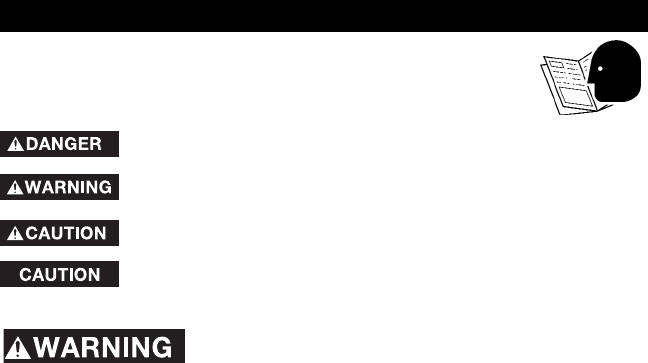
3
indicates an imminently hazardous situation which, if not
avoided, will result in death or serious injury.
indicates a potentially hazardous situation which, if not
avoided,could result in death or serious injury.
indicates a potentially hazardous situation which, if not
avoided,may result in minor or moderate injury.
used without the safety alert symbol indicates potentially
hazardous situation which, if not avoided, may result in
property damage.
SAFETY GUIDELINES - DEFINITIONS
It is important for you to read and understand this manual. The
information it contains relates to protecting YOUR SAFETY and
PREVENTING PROBLEMS. The symbols below are used to help
you recognize this information.
SAVE THESE INSTRUCTIONS!
● Wear eye and hearing protection. Always use safety glasses. Everyday
eyeglasses are NOT safety glasses. USE CERTIFIED SAFETY EQUIPMENT.
Eye protection equipment should comply with ANSI Z87.1 standards.
Hearing equipment should comply with ANSI S3.19 standards.
● Take precautions against dust inhalation. The dust generated by certain
woods and wood products can be injurious to your health. Always operate
machinery in well-ventilated areas, and provide for proper dust removal.
Use wood dust collection systems whenever possible. Also, use face or
dust mask if cutting operation is dusty. Dust mask protection should comply
with MSHA/NIOSH certified respirator standards. Splinters, air-borne debris,
and dust can cause irritation, injury, and/or illness.
● Do not pick up anything that is burning, smoldering, or smoking such as
matches, cigarettes, or hot ashes.
● Do not use to vacuum combustible explosive materials, such as coal,
grain, or other finely divided combustible material.
● Do not use to vacuum hazardous, toxic, or carcinogenic materials, such
as asbestos, pesticide or lead-based paint debris.
● Never pick-up explosive liquids (e.g. gasoline, diesel fuel, heating oil, paint
thinner, etc.), acids or solvents.

















